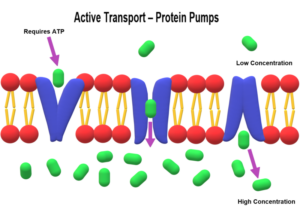Active transport requires energy while transporting the molecules or ions through the cell membrane as molecules are transported against the concentration gradient.
Active transport does require energy as it uses Adenosine triphosphate molecule (ATP) when transporting the molecules or ions from low concentration gradient to high concentration gradient.
In active transport there are two transporters namely primary active transport and secondary active transport.
Why does active transport require energy?
Active transport assist the transportation of molecules or ions from low concentration gradient to high concentration gradient so it requires energy.
In active transport the molecules like glucose, amino acids travel from low concentration to high concentration gradient in the cell. While transporting the molecules it requires energy in the form ATP.
Why does active transport require energy input by the cell?
In active transport the molecules are transported against the concentration gradient hence the energy is needed.
In this transport the molecules or ions transported from low to high concentration gradient for this the cell energy is used.
The active transport is different from facilitated diffusion because it uses carrier proteins rather than the channel proteins which are used in facilitated diffusion process. The carrier proteins need energy for transporting the molecules in the form of ATP which is generated in the cell respiration process.

Why does active transport require energy and passive transport does not?
Active transport requires energy as it transports the biochemical molecules from low concentration gradient to high concentration gradient. But passive transport does not require energy as the process is opposite to active transport.
Active transport always requires energy because the biochemical molecules like glucose, amino acids, ions etc are transported against the concentration gradient. Where as in passive transport the molecules travel from high concentration gradient to low concentration gradient usually it occurs in cell diffusion process.
Does primary active transport require energy?
Yes primary active transport requires energy because in primary active transport the ions are trans located from low concentration gradient to high concentration gradient.
The primary active transport is mainly seen in ion pumps only and it consumes cell energy in the form of ATP molecule.
Except ion pumps no other molecules perform the primary active transport. In this transport the ATPase enzyme is used by the ion pumps. ATPase is a bi functional molecule as it can break the ATP molecules and can transfer molecules against their concentration gradient. While hydrolyzing the ATP molecules it produces electro chemical gradient. This electro chemical gradient helps in the maintaining the proper voltage in the cell membrane. This total process is seen in the sodium-potassium pumps. Hence these pumps are called electro genic pumps.
Does secondary active transport require energy?
Secondary active transport does not require energy but it uses electro chemical gradient which is produced during primary active transport.
No usually secondary active transport does not require energy. It works with the assistance of electro chemical gradient which is produced by the hydrolysis of ATP molecule during Primary active transport.
During secondary active transport the ions move to their normal concentration gradient. While transporting the ions it also helps in the transportation of molecules like glucose through the cell membrane. The secondary active transport can transfer molecules or ions in both the ways. Means that both the molecules move in one direction or in an opposite direction.
There are two types of carries proteins which assist secondary active transport. They are symporters and antiporters. Symporters transport both the molecules in single direction whereas antiporters transport the molecules in an opposite direction, it means that one molecule go in to the cell and another one come out of the cell.
| Read More On: Do Animal Cells Have A Cell Wall: Interesting FACT |
Frequently Asked Questions:
Does active transport require carrier proteins?
Yes active transport require some unique membrane carrier proteins.
Active transport require some special carrier proteins and are unique for molecule or ion. Carrier proteins may act as symporters and anti-porters.
Which transport does not need carrier proteins?
The passive transport does not need carrier proteins.
The passive transport does not require carrier proteins as it involves the diffusion of molecules or ions across the membrane.
Does secondary active transport need carrier proteins?
Yes the secondary active transport need carrier proteins.
The secondary active transport need carrier proteins as these proteins are helpful in the maintaining the equilibrium of ion gradient in the cell membrane.
Also Read:
- Example of potential energy to thermal energy
- Is kinetic energy conserved in an inelastic collision
- Electrical energy to chemical energy
- Example of mechanical energy to chemical energy
- What does not affect potential energy
- Chemical energy to sound energy
- Example of chemical to mechanical energy
- Electrical energy to heat energy
- Example of kinetic to potential energy
- Example of gravitational energy to mechanical energy

Hi…I am Nagasrilakshmi Narne, a postgraduate in Biotechnology and English. also completed my B.Ed. I worked in Vimtalabs as a project trainee and I have work experience as a faculty of English. So I can explain topics in simple language.
Let’s connect through LinkedIn